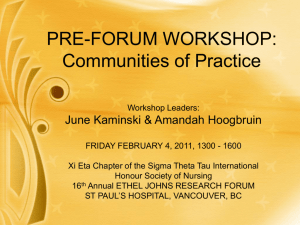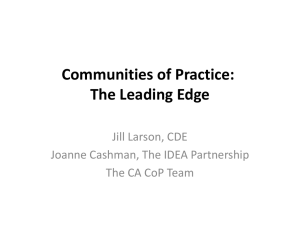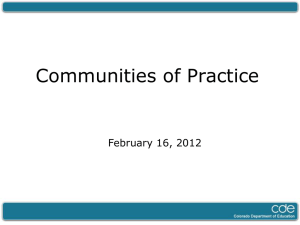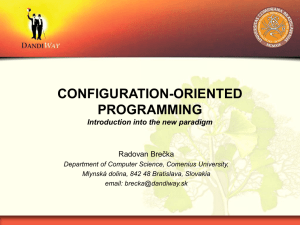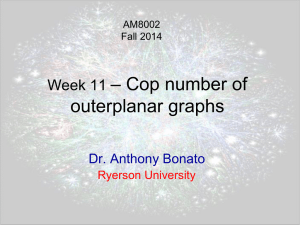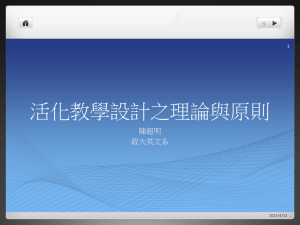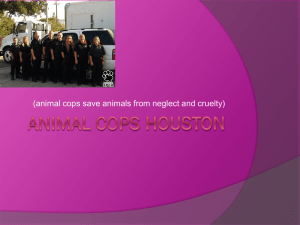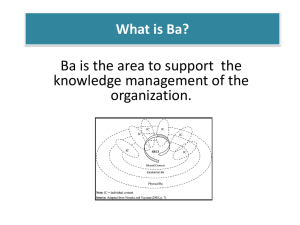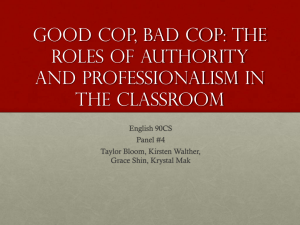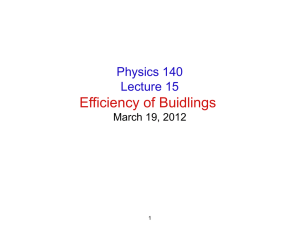Adams, A. (2012) - The Open University
advertisement
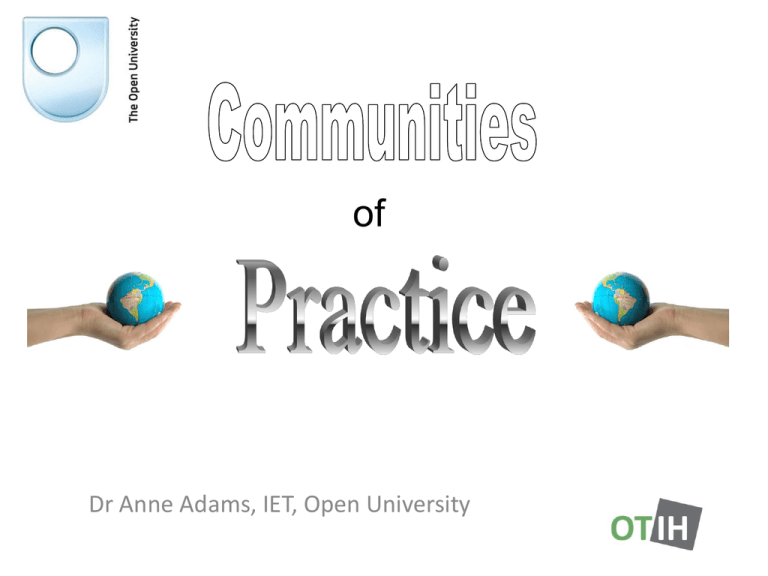
of Dr Anne Adams, IET, Open University Communities of Practice • Lave and Wenger (1991) – Situated Learning Learning NOT acquiring knowledge BUT social participation in SITUATION •Wenger (1998) CoP work-based learning situations •Establish meaning which is negotiated •Through community practices (participation and realisation) turn abstract / tacit norms into explicit understanding through. Dimensions of Practice • Joint enterprise – Negotiated by participants – Mutual accountability – Indigenous – made their own but within organisational constraints • Mutual engagement – Diversity of skills, knowledge, values, etc. – Inclusion – Engagement social as well as work-related • Shared repertoire – Terms – Environmental cues (e.g. piles of paper) – Evolving over time CoP: BOUNDARIES • Membership defined by shared practices, tools, terminology, markers, etc. – Hence a CoP has an inside and an outside … but also a boundary or periphery – Boundaries fluid – not institutional • CoP not closed – interacts with others • Brokering organises interconnections between CoPs • Boundary objects mediate interconnections. •Modularity – Used by different CoPs. E.g. DL for different groups •Abstraction – Common core for different CoPs •Accommodation – Lends itself to different activities. E.g. DL, medical notes, diagnosis, information for patients •Standardisation – Each CoP knows how to work with it COP: Legitimate Peripheral Participation • CoPs form, develop, evolve, disperse through learning. • Legitimate peripheral participation: – Legitimate: accepted by core members – Peripheral: learning to belong and participate • Learners become competent and they move from ‘legitimate peripheral participation’ into full participation. Pros and Cons for Scholarship Processes & Transitions situated in real world practices & communities. People straddle more than one CoP Power only seen as pervasive forms of discipline sustained by discourse. CoPs often seen as positive phenomenon yet destructive e.g. Nazis a CoP. COP: Legitimate Peripheral Participation • CoPs form, develop, evolve, disperse through learning. • Legitimate peripheral participation: – Legitimate: accepted by core members – Peripheral: learning to belong and participate • Learners become competent and they move from ‘legitimate peripheral participation’ into full participation. Preece: Online Communities • • • • • Not just tools and resources for CoP Also about social interaction Pay attention to sociability issues Norms & Online etiquette Social capital Healthcare DLs as Boundary Objects • Intermediaries support boundary object trust. • Further research uncovers the role of boundary creatures working with boundary objects between CoP. • Are ALs boundary creatures Suggested Reading • Lave, J & Wenger, E (1991) Situated Learning: Legitimate Peripheral Participation, CUP. • Wenger, E. (1998) Communities of Practice: Learning, Meaning and Identity, CUP. • Adams, A., Blandford, A. & Lunt, P. (2005) Social Empowerment and Exclusion: a case study on Digital Libraries. Available from http://oro.open.ac.uk/6704/ • Preece, J. (2004) Etiquette and trust drive online communities of practice. J Universal Computer Science. • http://www.infed.org/biblio/communities_of_practice.htm • http://www.co-i-l.com/coil/knowledgegarden/cop/index.shtml
